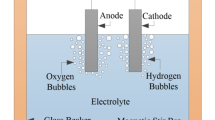Abstract
The present work is based on the study of the electrochemical response of mild steel as a function of machining configurations. The variable parameters were rake angle and turning speed, while feed rate and depth of cut remained fixed. Dynamic polarization tests and electrochemical impedance spectroscopy in 3.5% NaCl solution were done to analyze the electrochemical behavior of mild steels with the variation of rake angle and turning speed. The electrochemical response showed that the steel machined at higher speed and positive rake angle had higher resistance to charge transfer. Similarly, steel machined at lower speed and negative rake angle showed lower resistance to charge transfer. The results obtained in this study suggest that machining on mild steel should be carried out at positive rake angle and at higher speed to have smoother surface finish, strain-relieved surface grains, and subsequently better corrosion resistance, which was measured from corrosion current as determined by the Tafel extrapolation from the polarization plots.




Similar content being viewed by others
References
C.Y. Nian, W.H. Yangand, and Y.S. Tarng, Optimization of Turning Operations with Multiple Performance Characteristics, J. Mater. Process. Technol., 1999, 95, p 90–96
K. Hussain, D.S. Wilkinson, and J.D. Embury, Effect of Surface Finish on High Temperature Fatigue of a Nickel Based Super Alloy, Int. J. Fatigue, 2009, 31, p 743–750
R. Dubovska, J. Jambor, and J. Majerik, Qualitative Aspects of Machined Surfaces of High Strength Steels, Procedia Engineering 24th DAAAM International Symposium on Intelligent Manufacturing and Automation 2013, 2014, 69, p 646–654
S. Ghosh and V. Kain, Microstructural Changes in AISI, 304L Stainless Steel Due to Surface Machining: Effect on Its Susceptibility to Chloride Stress Corrosion Cracking, J. Nucl. Mater., 2010, 403, p 62–67
J. Cai, S. Shekhar, J. Wang, and M.R. Shankar, Nanotwinned Microstructures from Low Stacking Fault Energy Brass by High-Rate Severe Plastic Deformation, Scr. Mater., 2009, 60, p 599–602
S.G. Lee, J.H. Hwang, M.R. Shankar, S. Chandrasekar, and W.D. Compton, Large Strain Deformation Field in Machining, Metall. Mater. Trans., 2006, 37A, p 1633–1643
S. Swarninathan, M.R. Shankar, S. Lee, J. Hwang, A.H. King, R.F. Kezar, B.C. Rao, T.L. Brown, S. Chandrasekar, W.D. Compton, and K.P. Trumble, Large Strain Deformation and Ultra-Fine Grained Materials by Machining, Mater. Sci. Eng. A, 2005, 410, p 358–363
S. Shekhar, S. Abholghasem, S. Basu, J. Cai, and M.R. Shankar, Effect of Severe Plastic Deformation in Machining Elucidated via Rate-Strain-Microstructure Mappings, J. Manuf. Sci. Eng., 2012, 134, p 031008–031019
M. Yamashita, H. Miyukl, Y. Matsuda, H. Nagano, and T. Misawa, The Long Term Growth of the Protective Rust Layer Formed on Weathering Steel by Atmospheric Corrosion During a Quarter of a Century, Corros. Sci., 1994, 36, p 283–299
T. Misawa, K. Asami, K. Hashimoto, and S. Shimodaira, The Mechanism of Atmospheric Rusting and the Protective Amorphous Rust on Low Alloy Steel, Corros. Sci., 1974, 14, p 279–289
J.M. Costa, M. Morcillo, and S. Feliu, Effect of Environmental Parameters on Atmospheric Corrosion of Metals, Encyclopedia of Environmental Control Technology, Air Pollut. Control, 1989, 2, p 197–238
D. de la Fuente, I. Díaz, J. Simancas, B. Chico, and M. Morcillo, Long Term Atmospheric Corrosion of Mild Steel, Corros. Sci., 2011, 53, p 604–617
S.J. Oha, D.C. Cook, and H.E. Townsend, Atmospheric Corrosion of Different Steels in Marine, Rural and Industrial Environments, Corros. Sci., 1999, 41, p 1687–1702
J. Gravier, V. Vignal, and S.S. Bissey-Breton, Influence of Residual Stress, Surface Roughness and Crystallographic Texture Induced by Machining on the Ion Behaviour of Copper in Salt-Fog Atmosphere, Corros. Sci., 2012, 61, p 162–170
P. Mazumdar, S. Shekhar, and K. Mondal, Effect of Machining Parameters on Oxidation Behavior of Mild Steel, J. Mater. Eng. Process., 2015, 24, p 484–498
M. Prakash, S. Shekhar, A.P. Moon, and K. Mondal, Effect of Machining Configuration on the Corrosion of Mild Steel, J. Mater. Process. Technol., 2015, 219, p 70–83
H. Lee, D. Kim, J. Jung, Y. Pyoun, and K. Shin, Influence of Pinning on the Corrosion Properties of AISI, 304 Stainless Steel, Corros. Sci., 2009, 51, p 2826–2830
J. Liang, M.A. Wahab, and S.M. Guo, Corrosion Behavior of SS304 with Ball Milling and Electrolytic Plasma Treatment in NaCl Solution, in Mechanics of Time Dependent Materials and Processes in Conventional and Multifunctional Materials, Conference Proceedings of the Society for Experimental Mechanics Series 99999, T. Proulx, Ed., 2011, p 73–80.
M.E.P. Souza, E. Ariza, M. Ballester, L.A. Rocha, and C. Freire, Comparative Behaviour in Terms of Wear and Corrosion Resistance of Galvanized and Zinc-Iron Coated Steels, Revista Matéria, 2007, 12, p 618–623
B. Panda, R. Balasubramaniam, and G. Dwivedi, On the Corrosion Behaviour of Novel High Carbon Rail Steels in Simulated Cyclic Wet-Dry Salt Fog Conditions, Corros. Sci., 2008, 50, p 1684–1692
A. Moon, S. Sangal, and K. Mondal, Corrosion Behaviour of New Railway Axle Steels, Trans. Indian Inst. Met., 2013, 66, p 33–41
A. Moon, S. Sangal, S. Srivastav, N.S. Gajbhiye, and K. Mondal, Corrosion Behavior of IF Steel in Various Media and Its Comparison with Mild Steel, J. Mater. Eng. Perform., 2015, 25, p 85–97
Acknowledgment
The work has been supported by the Indian Space Research Organization, India (Project No: STC/MET/20120330).
Author information
Authors and Affiliations
Corresponding author
Rights and permissions
About this article
Cite this article
Prakash, M., Moon, A.P., Mondal, K. et al. Effect of Machining Configurations on the Electrochemical Response of Mild Steel in 3.5% NaCl Solution. J. of Materi Eng and Perform 24, 3643–3650 (2015). https://doi.org/10.1007/s11665-015-1639-2
Received:
Revised:
Published:
Issue Date:
DOI: https://doi.org/10.1007/s11665-015-1639-2




